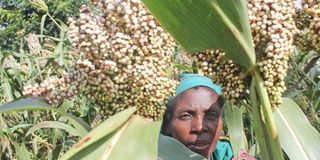Millet consumption could reduce heart diseases, new study reveals

Ms Syprose Atieno inspects millet at her farm in Sidho, Muhoroni, of Kisumu County. A new study has shown that eating millet can reduce the risk of developing type 2 diabetes.
The consumption of millet can reduce risk of developing cardiovascular disease according to a new study. The study was undertaken by five organisations and led by the International Crops Research Institute for the Semi-Arid Tropics (ICRISAT).
In Kenya there is a lower consumption per head which stands at 33 per cent of consumer demand. The Kenya Agricultural and Livestock Research Organisation (Kalro) in collaboration with partners has developed new finger millet varieties to boost production and meet the rising demand for the cereal in the country.
The new varieties are set to scale up yields and to address the gap in production which has dropped from 126,000 metric tons in 2014 to 72,000 metric tons in 2018.
The decline in production has led to less trade opportunities, minimal consumption and limited potential of the crop to enhance livelihoods of farmers.
The consumption of millet can reduce total cholesterol, triacylglycerols (commonly known as triglycerides) and BMI according to a new study analysing the data of 19 studies, with nearly 900 people.
The study was undertaken by five organisations and led by the International Crops Research Institute for the Semi-Arid Tropics (ICRISAT).
Obesity
The results published in Frontiers in Nutrition, brings critically needed scientific backing to the efforts to popularise and return millets back to diets, especially as staples, to combat the growing prevalence of obesity and being overweight in children, adolescents and adults.
In Kenya millet is grown in Kisii, Bungoma, Kericho and Bomet counties among other counties.
The study showed that consuming millets reduced total cholesterol by 8 percent lowering it from high to normal levels in the people studied.
There was nearly a 10 per cent decrease in low and very low-density lipoprotein cholesterol (commonly viewed as ‘bad cholesterol’) and triacylglycerol levels in blood.
Through these reductions, the levels went from above normal to normal range. In addition, consuming millets decreased blood pressure with the diastolic blood pressure decreasing by 5 per cent.
Dr S Anitha, the study’s lead author and Senior Nutritionist at ICRISAT, explained, “We were very surprised how many studies on humans had already been undertaken on the impact of millets on elements that impact cardiovascular diseases, and this is the very first time anyone has collated all these studies and analysed their data to test the significance of the impact. We used a meta-analysis, and results came out very strongly to show significant positive impact on risk factors for cardiovascular disease.”
The study also showed that consuming millets reduced Body mass index (BMI) by 7percent in people who were overweight and obese, showing the possibility of returning to a normal BMI.
All results are based on consumption of 50 to 200 g of millets per day for a duration ranging from 21 days to three months.
These findings are influenced by comparisons that show that millets are much higher in unsaturated fatty acids, with 2 to 10 times higher levels than refined wheat and milled rice as well as being much higher than whole grain wheat.
“This latest review further emphasizes the potential of millets as a staple crop that has many health benefits. It also strengthens the evidence that eating millet can contribute to better cardiovascular health by reducing unhealthy cholesterol levels and increasing the levels of whole grains and unsaturated fats in the diet,” said Professor Ian Givens, a co-author of the study and Director at University of Reading’s Institute of Food, Nutrition and Health (IFNH) in the UK.
“Obesity and being overweight are increasing globally in both wealthy and poorer countries, so the need for solutions based on healthier diets is critical. This new information on the health benefits of millets further supports the need to invest more in the grain, including its whole value chain from better varieties for farmers through to agribusiness developments,” said Dr. Jacqueline Hughes, Director General, ICRISAT.
Cardiovascular health
The study identified a number of priority future research areas including the need to study all different types of millet, understand any differences by variety alongside the different types of cooking and processing of millets and their impact on cardiovascular health.
Given the positive indicators to date, more detailed analysis on the impact of millets on weight management is also recommended. All relevant parameters are also recommended to be assessed to gain a deeper understanding of the impacts of millet consumption on hyperlipidemia and cardiovascular disease.
“A key recommendation from the study is for the government and industry to support efforts to diversify staples with millet, especially across Asia and Africa. Given that millets are hardy and climate smart, returning to this traditional staple makes a lot of sense and is a critical solution that could be the turning point of some major health issues,” highlighted Ms. Joanna Kane-Potaka, a co-author and Executive Director of the Smart Food initiative, ICRISAT.




